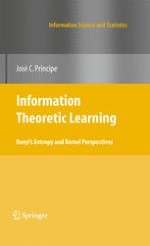2010 | OriginalPaper | Chapter
8. Self-Organizing ITL Principles for Unsupervised Learning
Authors : Sudhir Rao, Deniz Erdogmus, Dongxin Xu, Kenneth Hild II
Published in: Information Theoretic Learning
Publisher: Springer New York
Activate our intelligent search to find suitable subject content or patents.
Select sections of text to find matching patents with Artificial Intelligence. powered by
Select sections of text to find additional relevant content using AI-assisted search. powered by
